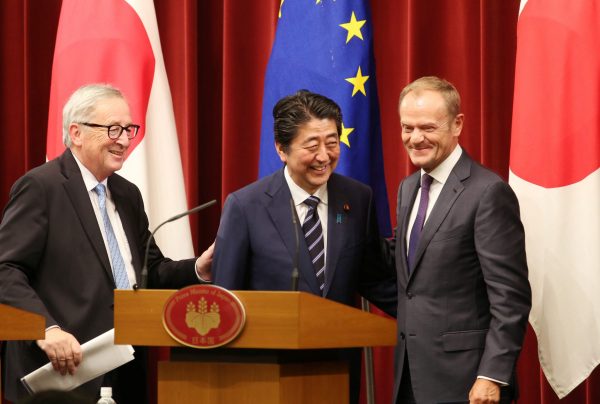Although the mass media has given low-key attention to the Japan–EU EPA so far, it is going to be an important agreement for the international trade policy regime. Its significance is found in the following three points.
First, its size. The agreement is going to be both Japan’s and the EU’s largest free trade agreement, covering 640 million people and 28 per cent of world GDP. For comparison, the Comprehensive and Progressive Agreement for Trans-Pacific Partnership (CPTPP) will cover just 13 per cent of world GDP even if all 11 countries ratify it.
Second, its content. The agreement’s commitments in terms of market access and rule-making are both high and wide, almost equivalent to the CPTPP with some EU-specific elements also incorporated.
For market access, the level of liberalisation commitments is respectable, except in Japan’s agricultural sector. The import tariff removal ratio in terms of the number of tariff lines reaches 99 per cent on the EU side while that of Japan is 94 per cent. Japan’s agricultural, forestry and fishery products are at 82 per cent and manufactured goods at 100 per cent.
Services and investment liberalisation is deep and follows the negative-list approach (where it is specified which items will not be liberalised rather which ones will be). The coverage of the entry of natural persons and temporary stay is widened beyond the World Trade Organization’s General Agreement on Trade in Services commitments.
For rule-making, some interesting differences are found from the CPTPP, along with the EU’s interest in the removal of ‘non-tariff barriers’. Some of these items may become focal points in rule-making at the global level in the future.
For the rules of origin, intermediate inputs coming from a third country with which Japan or the European Union has a free trade agreement may be counted as value added in Japan or the European Union under certain conditions. In contrast to the United States’ recent inclination towards stricter rules of origin, this may help some industries, such as the automobile industry, to extend their international production networks further.
The coverage of the non-discrimination principle in government procurement is mutually expanded beyond the World Trade Organization’s Government Procurement Agreement, particularly for the railway sector.
The geographical indications for agricultural products, food and beverages are emphasised in the Intellectual Property Chapter. The geographical indications for 71 items on the EU side and 48 items on the Japanese side will be mutually protected. Cooperation for animal welfare, which has not attracted much public attention in Japan yet, is included in the Regulatory Cooperation Chapter. The harmonisation of safety and environmental standards for automobiles was also intensively discussed on the sidelines.
Negotiations over investment disputes, separated from investment liberalisation, did not reach a conclusion. Japan pushed for investor–state dispute settlements along the lines of the Trans-Pacific Partnership, while the European Union opposed this suggestion and proposed to set up a designated investment court system. Further negotiations will follow for a coming investment treaty.
Different from the CPTPP, free flow of data and prohibition of data localisation requirements were not included in the Japan–EU EPA. But in a separate negotiation, Japan will get a reciprocal ‘adequacy decision’ status for the General Data Protection Regulation, which will basically allow personal data to move between the European Union and Japan.
The agreement will contribute to worldwide efforts to deter rising trade protectionism and promote the rules-based international trade policy regime. Together with the CPTPP, which is also supposed to be validated soon, the Japan–EU EPA will present a clear message about the importance of further trade liberalisation and international rule-making. It will generate visible trade diversion effects against the US private sector, which may motivate the White House to seriously think about returning to the normal track. It will also accelerate negotiations over other integration efforts such as the Regional Comprehensive Economic Partnership.
Trade wars are harmful and anachronistic. The international division of labour is qualitatively changing and newly developed economies such as China are substantial in size. The world must aggressively utilise mega-FTAs to catch up with the ongoing transformations in global economic activity.
Fukunari Kimura is Professor in the Faculty of Economics, Keio University and Chief Economist at the Economic Research Institute for ASEAN and East Asia (ERIA).

